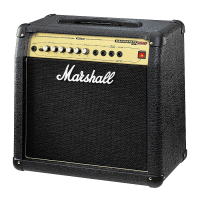
Do you have a question about the Marshall Amplification Valvestate 2000 AVT AVT20 and is the answer not in the manual?
| Brand | Marshall Amplification |
|---|---|
| Model | Valvestate 2000 AVT AVT20 |
| Category | Musical Instrument Amplifier |
| Language | English |
Crucial safety guidelines for operating the amplifier, covering mains leads, fuses, servicing, and environmental conditions.
Details the evolution of Marshall Valvestate amplifiers from the early 90s to the present.
Explains the focus on guitarist-friendly features and achieving valve-like tone and feel.
Highlights the use of ECC83 valves in preamp stages for enhanced tone and dynamics.
Introduces the AVT20, AVT50 combos, and AVT50H head as powerful amps.
Connection point for your guitar, emphasizing the use of screened, high-quality cables.
Switch to select between the Clean and Overdrive channels for different tonal characteristics.
Adjusts the amount of distortion or 'break-up' for both Clean and Overdrive channels.
Controls the overall output volume and can contribute to power amp distortion at higher levels.
Passive Bass, Middle, and Treble EQ controls that influence tone across both channels.
Adjusts the intensity of the internal spring reverb effect.
Allows playing along with external audio sources like CD or tape players.
Provides a speaker-emulated output signal for direct recording or live sound.
For practicing in silence; also disconnects the main loudspeaker.
Connects the amplifier to external speaker cabinets for expanded sound.
Connection point for the detachable mains power lead.
Connection point for your guitar, emphasizing the use of screened, high-quality cables.
Adjusts the gain for the Clean channel, offering clean to crunch tones.
Controls the output volume for the Clean channel.
Bass and Treble controls for the Clean channel, featuring a pre-set mid scoop.
Selects between the Clean and Overdrive channels; must be 'in' for footswitch operation.
Sets the gain for the Overdrive channel, from vintage to high-gain tones.
Controls the output volume for the Overdrive channel.
Bass, Middle, and Treble EQ controls for the Overdrive channel.
Adjusts the intensity of the internal spring reverb effect.
Allows playing along with external audio sources like CD or tape players.
For practicing in silence; also disconnects the main loudspeaker.
Connection point for the detachable mains power lead.
Connects to the internal loudspeaker or an external cabinet.
Provides a speaker-emulated output signal for direct recording or live sound.
Input for external effects units post-preamp stage.
Output to send signal to external effects units.
Connection for the footswitch to control channel switching and other functions.
Connection point for the detachable mains power lead.
Connects to external speaker cabinets; minimum total impedance required.
Provides a speaker-emulated output signal for direct recording or live sound.
Input for external effects units post-preamp stage.
Output to send signal to external effects units.
Connection for the footswitch to control channel switching and other functions.